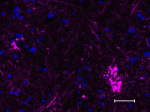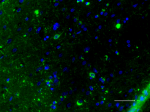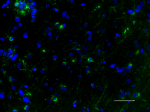- Clone
- M7004D06 (See other available formats)
- Regulatory Status
- RUO
- Other Names
- Microtubule associated protein tau
- Isotype
- Mouse IgG1, κ
- Ave. Rating
- Submit a Review
- Product Citations
- publications

-

IHC staining of Alexa Fluor® 647 anti-Tau phospho (Thr181) antibody (clone M7004D06) on formalin-fixed paraffin-embedded Alzheimer's disease brain tissue. Following antigen retrieval using Sodium Citrate H.I.E.R. (Cat. No. 420902), the tissue was incubated with 5 µg/ml of the primary antibody overnight at 4°C. Nuclei were counterstained with DAPI, and the slide was mounted with ProLong™ Gold Antifade Mountant. The image was captured with a 40X objective. Scale Bar: 50 µm
| Cat # | Size | Price | Quantity Check Availability | Save | ||
|---|---|---|---|---|---|---|
| 846607 | 25 µg | £109 | ||||
| 846608 | 100 µg | £238 | ||||
Tau protein promotes microtubule assembly and stability. Tau is abundant in neurons of the central nervous system, and is expressed at low levels in astrocytes and oligodendrocytes. Abnormal hyper-phosphorylation, aggregation, and toxic gain of function of tau is associated with several neurological disorders, including Alzheimer’s disease (AD). The major building block of neurofibrillary lesions in AD brains consists of paired helical filaments (PHFs) of abnormally hyperphosphorylated tau. Recent studies indicate that cerebrospinal fluid tau phosphorylated at position threonine 181 has diagnostic utility for several neurological disorders. Six isoforms of tau are generated by alternative splicing of the MAPT gene. These isoforms are distinguished by the number of tubulin binding domains, 3 (3R) or 4 (4R), in the C-terminal of the protein and by one (1N), two (2N), or no (0N) inserts in the N-terminal domain. Tau isoforms are differentially expressed during development.
Product DetailsProduct Details
- Verified Reactivity
- Human
- Antibody Type
- Monoclonal
- Host Species
- Mouse
- Immunogen
- 15-mer pT181 Tau peptide conjugated to KLH.
- Formulation
- Phosphate-buffered solution, pH 7.2, containing 0.09% sodium azide.
- Preparation
- The antibody was purified by affinity chromatography and conjugated with Alexa Fluor® 647 under optimal conditions.
- Concentration
- 0.5 mg/ml
- Storage & Handling
- The antibody solution should be stored undiluted between 2°C and 8°C, and protected from prolonged exposure to light. Do not freeze.
- Application
-
IHC-P - Quality tested
SB - Community verified - Recommended Usage
-
Each lot of this antibody is quality control tested by formalin-fixed paraffin-embedded immunohistochemical staining. For immunohistochemistry, a concentration range of 1.0 - 10 µg/ml is suggested. It is recommended that the reagent be titrated for optimal performance for each application.
* Alexa Fluor® 647 has a maximum emission of 668 nm when it is excited at 633 nm / 635 nm.
Alexa Fluor® and Pacific Blue™ are trademarks of Life Technologies Corporation.
View full statement regarding label licenses - Excitation Laser
-
Red Laser (633 nm)
- Additional Product Notes
-
This product has been verified for IHC-F (Immunohistochemistry - frozen tissue sections) on the NanoString GeoMx® Digital Spatial Profiler. The GeoMx® enables researchers to perform spatial analysis of protein and RNA targets in FFPE and fresh frozen human and mouse samples. For more information about our spatial biology products and the GeoMx® platform, please visit our spatial biology page.
- RRID
-
AB_2801183 (BioLegend Cat. No. 846607)
AB_2801184 (BioLegend Cat. No. 846608)
Antigen Details
- Structure
- Unmodified Tau isoforms have an apparent molecular weight ranging from 33-79 kD. Additional high and low molecular weight Tau species have been observed in brain tissues.
- Distribution
-
Tissue distribution: central nervous system, peripheral ganglia and nerves, kidney, skeletal, and heart muscle.
Cellular distribution: cytoskeleton, nucleus, plasma membrane, and cytosol. - Function
- Tau promotes microtubule assembly and stability. The short tau isoforms allow plasticity of the cytoskeleton whereas the longer isoforms may preferentially play a role in its stabilization.
- Interaction
- Tau interacts with Sequestosome-1, Peptidyl-prolyl cis-trans isomerase FKBP4, Casein kinase I isoform delta, Serine/threonine-protein kinase Sgk1, Laforin, Alpha-synuclein
- Molecular Family
- Phospho-Proteins, Tau
- Antigen References
-
1. Meredith JE Jr, et al. 2013. PLoS One 8(10):e76523. PubMed
2. Goodall CA, et al. 2006. J. Neurol. Neurosurg. Psychiatry 77(1):89. PubMed - Gene ID
- 4137 View all products for this Gene ID
- UniProt
- View information about Tau Phospho Thr181 on UniProt.org
Related Pages & Pathways
Pages
Related FAQs
- If an antibody clone has been previously successfully used in IBEX in one fluorescent format, will other antibody formats work as well?
-
It’s likely that other fluorophore conjugates to the same antibody clone will also be compatible with IBEX using the same sample fixation procedure. Ultimately a directly conjugated antibody’s utility in fluorescent imaging and IBEX may be specific to the sample and microscope being used in the experiment. Some antibody clone conjugates may perform better than others due to performance differences in non-specific binding, fluorophore brightness, and other biochemical properties unique to that conjugate.
- Will antibodies my lab is already using for fluorescent or chromogenic IHC work in IBEX?
-
Fundamentally, IBEX as a technique that works much in the same way as single antibody panels or single marker IF/IHC. If you’re already successfully using an antibody clone on a sample of interest, it is likely that clone will have utility in IBEX. It is expected some optimization and testing of different antibody fluorophore conjugates will be required to find a suitable format; however, legacy microscopy techniques like chromogenic IHC on fixed or frozen tissue is an excellent place to start looking for useful antibodies.
- Are other fluorophores compatible with IBEX?
-
Over 18 fluorescent formats have been screened for use in IBEX, however, it is likely that other fluorophores are able to be rapidly bleached in IBEX. If a fluorophore format is already suitable for your imaging platform it can be tested for compatibility in IBEX.
- The same antibody works in one tissue type but not another. What is happening?
-
Differences in tissue properties may impact both the ability of an antibody to bind its target specifically and impact the ability of a specific fluorophore conjugate to overcome the background fluorescent signal in a given tissue. Secondary stains, as well as testing multiple fluorescent conjugates of the same clone, may help to troubleshoot challenging targets or tissues. Using a reference control tissue may also give confidence in the specificity of your staining.
- How can I be sure the staining I’m seeing in my tissue is real?
-
In general, best practices for validating an antibody in traditional chromogenic or fluorescent IHC are applicable to IBEX. Please reference the Nature Methods review on antibody based multiplexed imaging for resources on validating antibodies for IBEX.
Other Formats
View All Tau Phospho (Thr181) Reagents Request Custom Conjugation| Description | Clone | Applications |
|---|---|---|
| Purified anti-Tau Phospho (Thr181) | M7004D06 | IHC-P,Direct ELISA,WB |
| Alexa Fluor® 594 anti-Tau Phospho (Thr181) | M7004D06 | IHC-P,SB |
| Alexa Fluor® 647 anti-Tau Phospho (Thr181) | M7004D06 | IHC-P,SB |
| Alexa Fluor® 488 anti-Tau Phospho (Thr181) | M7004D06 | IHC-P,SB |
Compare Data Across All Formats
This data display is provided for general comparisons between formats.
Your actual data may vary due to variations in samples, target cells, instruments and their settings, staining conditions, and other factors.
If you need assistance with selecting the best format contact our expert technical support team.
-
Purified anti-Tau Phospho (Thr181)

IHC staining of anti-Tau Phospho (Thr181) antibody (clone M7... 
IHC staining of purified anti-Tau phospho (Thr181) antibody ... 
Western blot of anti-Tau Phospho (Thr181) (clone M7004D06), ... 
Direct ELISA of purified anti-Tau Phospho (Thr181) antibody ... -
Alexa Fluor® 594 anti-Tau Phospho (Thr181)

IHC staining of Alexa Fluor® 594 anti-Tau phospho (Thr181) ... -
Alexa Fluor® 647 anti-Tau Phospho (Thr181)

IHC staining of Alexa Fluor® 647 anti-Tau phospho (Thr181) ... -
Alexa Fluor® 488 anti-Tau Phospho (Thr181)

IHC staining of Alexa Fluor® 488 anti-Tau Phospho (Thr181) a... 
IHC staining of Alexa Fluor® 488 anti- anti-Tau Phospho (Thr...
 Login / Register
Login / Register 












Follow Us